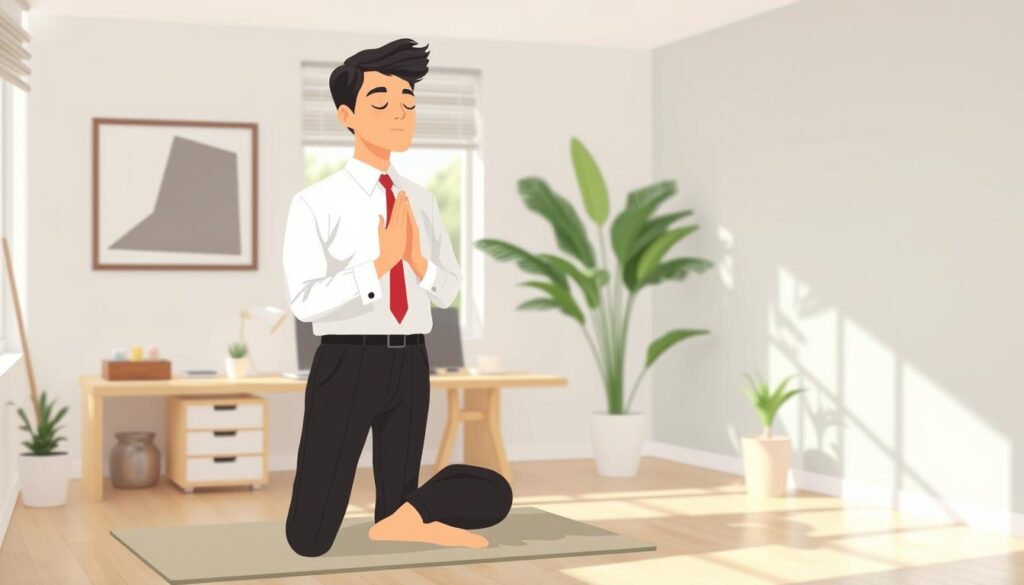Can you stay focused and productive despite the chaos of a demanding workday? In today’s fast-paced professional world, stress and burnout are increasingly common. But what if you could find tranquility amid the chaos without stepping away from your office?
Enter mindfulness—a powerful tool that busy professionals can seamlessly incorporate into their daily routines. By practicing mindfulness, you can enhance your ability to stay present and focused, leading to improved productivity and overall well-being.
Mindfulness is about being centered in the present moment, allowing you to tackle challenges with clarity and composure. As you explore the benefits of mindfulness, you’ll discover how it can transform your workday, improving your focus and reducing stress.
Key Takeaways
- Mindfulness practices can be integrated into a busy workday to reduce stress.
- Practicing mindfulness improves focus and productivity.
- Mindfulness techniques can be discreetly practiced at your desk.
- The benefits of mindfulness include better emotional regulation and problem-solving abilities.
- Mindfulness is not traditional meditation; it’s about being present.
The Power of Mindfulness in a Fast-Paced Professional World
In today’s fast-paced professional world, mindfulness is a game-changer. As professionals, you’re constantly juggling multiple tasks, deadlines, and responsibilities, often leading to increased stress levels and decreased productivity.
Mindfulness helps to reduce stress by activating the body’s relaxation response, leading to lower stress levels and improved focus. By incorporating mindfulness into your daily routine, you can enhance your overall well-being and productivity.
Understanding Mindfulness and Its Benefits for Professionals
Mindfulness is the practice of being present in the moment, paying attention to your thoughts, feelings, and sensations without judgment. Regular mindfulness practice can lead to numerous benefits, including improved emotional regulation, enhanced creativity, and better decision-making. By being more mindful, you can improve your attention and focus, leading to greater productivity and efficiency in your work.
Why Busy Professionals Need Mindfulness More Than Anyone
Busy professionals often face unique challenges, such as high-pressure deadlines, complex decision-making, and managing workplace conflicts. Mindfulness is particularly effective in helping professionals navigate these challenges by reducing stress levels and improving their overall mental and physical health. By incorporating mindfulness into their daily routine, busy professionals can improve their resilience, leading to a better life and work balance.
7 Amazing Mindfulness Techniques for Busy Professionals
Mindfulness techniques offer a powerful tool for managing stress and improving productivity in the workplace. By incorporating these practices into your daily routine, you can enhance your overall well-being and professional performance.
1. One-Minute Relaxation Breathing for Instant Calm

One-Minute Relaxation Breathing is a simple yet effective technique for reducing stress. To practice, sit or lie down comfortably, place one hand on your chest and the other on your abdomen, inhale deeply through your nose, feeling your abdomen expand, and exhale slowly through your mouth, feeling your abdomen fall. Repeat for several rounds.
This technique triggers the parasympathetic nervous system, providing quick stress relief between meetings or before important presentations.
2. Body Scan Meditation to Release Workplace Tension

Body Scan Meditation involves finding a quiet moment, sitting comfortably, and closing your eyes. Mentally scan your body from head to toe, noticing any areas of tension. As you identify tense areas, consciously relax those muscles.
This technique helps release physical tension accumulated during focused work periods, improving overall comfort and reducing stress.
3. Five Senses Check-In for Rapid Refocusing
The Five Senses Check-In technique involves noticing five things you can see, four sounds, three things you can touch, two smells, and one taste. By engaging all your senses, you can bring your attention to the present moment and away from anxious or stressful thoughts.
This rapid mental reset is particularly useful when switching between different tasks or after dealing with challenging workplace situations.
4. Mindful Walking Between Meetings

Mindful Walking involves choosing a suitable walking route and focusing on the sensation of your feet touching the ground. Notice your surroundings, including the sights, sounds, and smells.
This technique transforms necessary transitions between meetings or spaces into opportunities for mental refreshment and gaining new perspectives.
5. Desk Stretching for Physical and Mental Relief

Desk Stretching involves moving for approximately three minutes every 30-60 minutes. Simple stretches can improve energy, mood, metabolism, and blood flow.
This technique releases physical tension that contributes to mental stress, improving overall comfort and productivity.
6. Mindful Eating During Your Lunch Break

Mindful Eating involves focusing on the food in front of you, engaging your senses to fully experience the colors, smells, tastes, textures, and even sounds.
By transforming your lunch break into a restorative practice, you can nourish both your body and mind, resetting for afternoon productivity.
7. Gratitude Practice for Professional Perspective

Gratitude Practice involves setting aside a few minutes each day for reflection, identifying three specific things you’re grateful for, and considering why these things are meaningful to you.
This technique helps maintain perspective and resilience during challenging work periods, fostering a positive and proactive mindset.
Integrating Mindfulness into Your Professional Routine
By weaving mindfulness into the fabric of your workday, you can enhance your ability to stay present and focused. This integration can be achieved through simple yet effective techniques that fit into your busy schedule.
Creating Mindful Triggers Throughout Your Workday
Identify natural transition points in your day, such as after checking email or before meetings, to practice brief mindfulness exercises. Use everyday workplace objects or activities as mindfulness anchors to transform ordinary moments into opportunities for presence and awareness.
Using Technology to Support Your Mindfulness Practice
Leverage mindfulness apps like Headspace, Calm, or Insight Timer for guided meditations tailored to busy professionals. These apps offer a variety of practices, including breathing exercises and meditations, to support your mindfulness journey.

Conclusion: Transforming Your Professional Life Through Mindfulness
By integrating mindfulness into your daily routine, you can unlock a more balanced and focused you. Mindfulness isn’t about adding another task to your to-do list; it’s about finding small moments of calm within your existing schedule. Techniques like mindful breathing, body scans, and gratitude practice can significantly reduce stress levels and improve your overall well-being.
Starting small is key. Begin with just a few minutes a day of mindfulness practice, and gradually increase as you become more comfortable with the techniques. This consistent practice can lead to improved focus and professional satisfaction over time. As you become more mindful, you’ll likely notice improvements in your professional relationships and leadership capabilities.
Remember, the goal of mindfulness isn’t perfection; it’s about making progress. By incorporating mindfulness into your daily life, you’ll be more centered, resilient, and better equipped to handle the challenges of your professional life. Start your mindfulness journey today and experience the positive impact it can have on your work and overall well-being.


[…] what are the key principles to follow? In this article, we’ll dive into the 7 rules of saving money to help you achieve your financial […]
[…] pressure between beats). The optimal blood pressure level is less than 120/80 mmHg. Healthcare professionals use these measurements to assess cardiovascular health, and understanding these numbers is vital […]